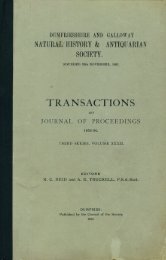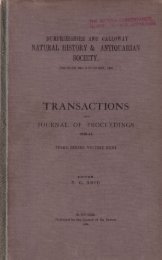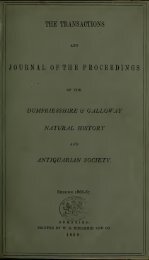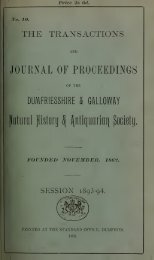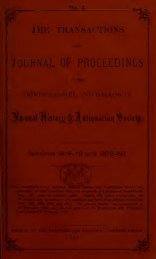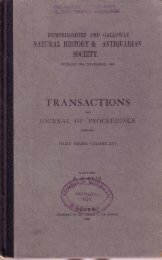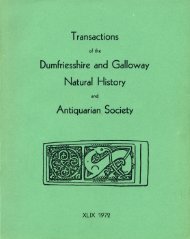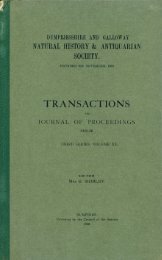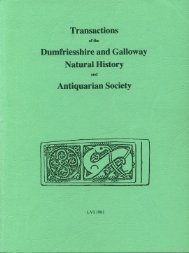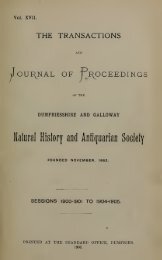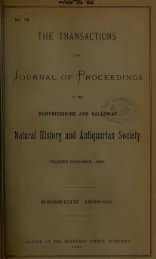Vol 5 - Dumfriesshire & Galloway Natural History and Antiquarian ...
Vol 5 - Dumfriesshire & Galloway Natural History and Antiquarian ...
Vol 5 - Dumfriesshire & Galloway Natural History and Antiquarian ...
Create successful ePaper yourself
Turn your PDF publications into a flip-book with our unique Google optimized e-Paper software.
Transactions. 37leads the salmon to return year after year to its native stream,<strong>and</strong> which lias a striking parallel among birds, as in the case ofthe swallow, but pass on to other migratory fishes, first noticingthe eels. Unlike the salmon, the eels spawn in the sea, if theydo spawn at all. At anyrate, they went down to the sea tobreed, <strong>and</strong> they came back again up the rivers ; <strong>and</strong> we find thatthe elvers, or young eels, come up about the month of May inlarge shoals. The older eels come up <strong>and</strong> run on spring tides,never waiting for a spate.The herring migrate, not to <strong>and</strong> from the Arctic regions, aswas repoi^ted by all the older naturalists—worthy men in theirtime, <strong>and</strong> who have h<strong>and</strong>ed down to us a lotof erroneous information—butsimply from deep toshallow water, <strong>and</strong> remain, Ibelieve, vei'y near our isl<strong>and</strong>s all tlie time. Their migration isvery largely dependent upon temperature. To give an idea oftlie extraordinary numbers of the herring, if we allow one herringfor every cubic foot, <strong>and</strong> assume a shoal to be a square mile inextent <strong>and</strong> eighteen feet deep, it would contain five hundredmillions of the fish. And there were a great many shoals ofvastly larger dimensions. Such were their immense quantity,<strong>and</strong> such their rapid rate of increase, that the' whole quantitycaught by man did not appreciably afiect their numbers, <strong>and</strong>they would choke up the sea if they were not eaten by other fishes.One of the fishes most destructive to the herring was the cod,which followed the shoals, <strong>and</strong> has been found very frequently inthe Solway now in the winter, at spots where the haddock usedformerly to be plentiful, but from which it ha.s disappeared.II. The Si/stem of L<strong>and</strong> Tenure in Scotl<strong>and</strong>.By Mr J. "W. Whitelaw.In this paper the author remarked that the system of l<strong>and</strong>tenure in Scotl<strong>and</strong> was of feudal origin, but that very littlefeudalism now remained except in nomenclature, <strong>and</strong> the theorythat the sovereign is the source <strong>and</strong> fountain of all rights in thel<strong>and</strong>. He traced tlie history of Feudalism from the earliesttimes, showing how the various changes were introduced, <strong>and</strong>described the rites <strong>and</strong> ceremonies of investure.



